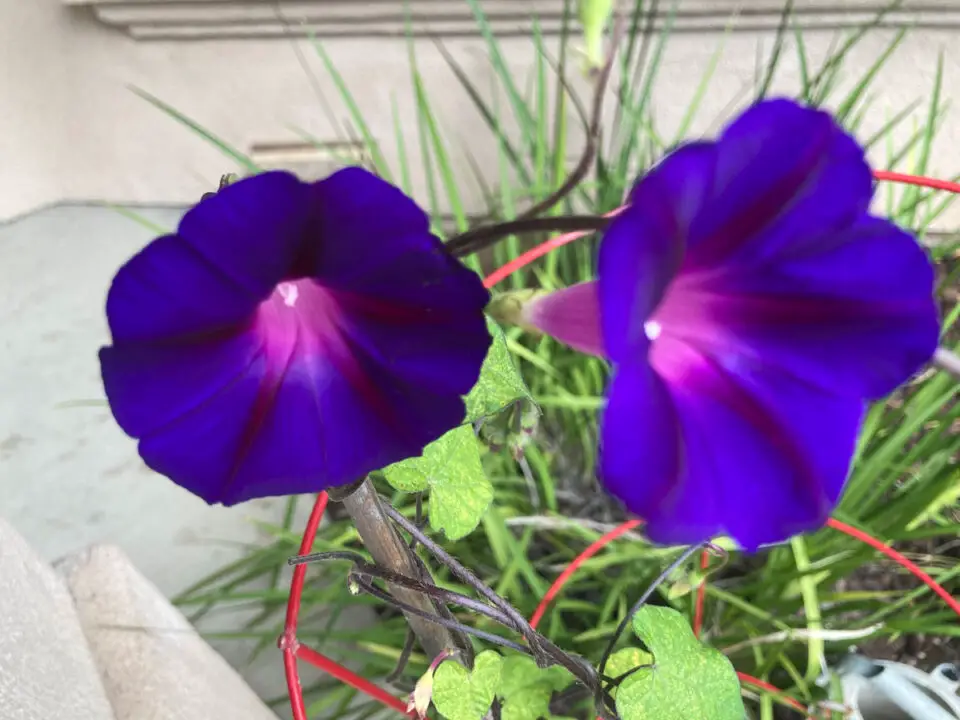I have a purple morning glory growing in my window box. It is the only tag-along flower that survived a move from my small house in Vista to another somewhat larger home in Vista.
When my son and I moved last November, we went from living in a small house with a large yard to a bigger house with virtually no yard at all.
So, I transferred my three-foot window box onto a tiny 48-inch plot of grass at the entryway and planned to fill it with flowers. The dirt remained empty for most of the summer.
Then, two tiny heart-shaped leaves popped up through the dirt one morning. From many years of growing this plant, I knew it was Grandpa Ott’s morning glory.
The two leaves progressed into a four-foot vine, climbing onto a tomato cage as the weeks passed. Finally, the magnificent bi-colored purple flower arrived, opening on cue at 8:00 a.m.
True to its name, the flower stayed open until the bloom finished its show in the early afternoon and fell to the ground.

WHY GRANDPA OTT’S?
For those of us obsessed with collecting and planting seeds, this morning glory has over two hundred years of history.
“Diane Ott Whealy received the seed from her grandfather, Grandpa Ott, whose parents brought the seed from Bavaria to Iowa when they immigrated in 1884,” according to Seed Savers Exchange.
“Seed Savers Exchange was founded in Missouri in 1975 by Diane Ott Whealy and Kent Whealy. Diane’s grandfather, Baptist John Ott, entrusted to them the seeds of two heirloom open-pollinated varieties, ‘Grandpa Ott’s’ morning glory and the ‘German Pink’ tomato. These seeds—brought by Grandpa Ott’s parents from Bavaria (Germany) when they immigrated to Iowa in 1884—became the first two varieties in the collection.”
Diane and Kent went on to form a network of gardeners, now called Exchange, interested in preserving heirloom varieties and bolstering biodiversity. These dedicated gardeners shared their heirloom seeds and donated seeds to the Seed Savers Exchange collection.
As the organization grew, individuals began donating their treasured seeds for preservation, resulting in over 20,000 open-pollinated varieties. With culturally diverse stewardship histories, this open-access collection represents America’s rich garden heritage.
“Today, we recognize the value of the stories and relationships behind the seeds in protecting this diversity as much as we value the seeds themselves. As part of the revitalization of Indigenous native food systems, many native communities are also developing vibrant seed initiatives to increase access to cultural and traditional healthy food,” said Rowen White, curator of the program.
Contact Seed Savers Exchange at www.seedsaversexchange.com for information about joining this enormous seed exchange program. Not only will you be able to receive hundreds of free seeds (when becoming a member), but you will also be an active participant in furthering the preservation of non-GMO seeds.
CREATING A LOCAL SEED COLLECTION
The Carlsbad Library has begun a yearlong seed collection purchased from Johnny’s Seed Company and also accepts seeds from local gardeners to be placed in small envelopes containing approximately one ounce that are free to library patrons.

The Carlsbad Community Garden Committee is also active in organizing the distribution of the library collection.
Suppose you want to join the seed collection revolution. In that case, the gardeners from the Carlsbad Senior Center Garden class have begun a weekly harvest of seeds and have harvested over 50 packages for the donation program.
Contact the Senior Center at (442) 339-2650 X 2 to register for the free garden class held each Tuesday morning at the Pine Street Community Garden.
HOW TO COLLECT SEEDS
What you will need:
Suggested plants to harvest: Marigolds, sunflowers, nasturtium, and cosmos
Four large plastic bowls
Tablecloth
White, 8 x 10 paper
Small coin envelopes (available at stationery stores); do not use plastic bags
Black Sharpie marker
- Choose four plants that you would like to harvest. Be sure that the seed pods are dry and brittle. In the case of sunflowers, ensure the seeds are hard and dry (usually black, not green).
- Place the seed pods in separate bowls.
- Spread the tablecloth on a large table, and place a white paper on the cloth.
- Place seedpods in a sieve and press lightly through the sieve to clean.
- The “chaff” will fall through the sieve and land on the white paper. This is how you will be able to separate the chaff from the seed, allowing for better germination.
- Place seeds in separate envelopes – label and date.
- Exchange with friends or donate to the Carlsbad Library Seed Collection. Call Darin Williamson @ (442) 339-2970 for further instructions.
Jano Nightingale is a Master Gardener and Horticulturist and teaches garden classes at the Carlsbad Senior Center. Contact her @[email protected].




